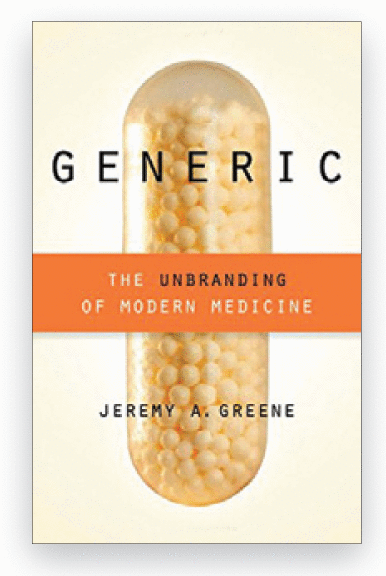Abstract
In his exhaustively researched new book, Generic: The Unbranding of Modern Medicine, physician-historian Jeremy A. Greene, MD, PhD, explores the rise of generic drugs in the U.S. and our evolving understanding of “generic equivalence.”
The generic drug provokes a paradox of similarity: We believe, and yet we do not believe, that similar things are the same. We believe, and yet we do not believe, that similar things are different. And we are not sure which forms of proof should convince us of their exchangeability.
—Generic: The Unbranding of Modern Medicine
Generic drugs, by definition, imply “sameness.” The Food and Drug Administration (FDA) requires that generic products have the same high quality, strength, purity, and stability as brand-name products. Consumers are told that generics provide the same therapeutic benefits as their branded counterparts. The federal law requiring a generic drug’s label to mirror the branded label is commonly referred to as “the duty of sameness.” But are generic and branded drugs ever really the same?

In his latest book, Generic: The Unbranding of Modern Medicine, physician-historian Jeremy A. Greene, MD, PhD, explores this notion of “sameness” and how our understanding of generic equivalence has evolved over the last several decades. Extensively researched and documented, the book also chronicles the rise of generic drugs in the United States, from “suspect” substances in the mid-20th century to now widely accepted and commonplace products that command more than 80% of the prescription-drug market. Dr. Greene’s gripping and eye-opening accounts of the scientific, social, and political debates that happened along the way keep the reader hooked and engaged.
When generic drugs were introduced to the American public in the late 1960s, it was assumed that if they were chemically identical to their brand-name counterparts, they were interchangeable as therapeutics. As Dr. Greene points out, while we still like to think of generic drugs as the “same but cheaper,” they are never fully identical to their respective brand-name products; rather, their claims to being the same are based on being “the same in all ways that matter,” that is to say, in ways that make them work in the body.
The second half of the 20th century saw chemical claims of similarity challenged by new tests and protocols for demonstrating biological, physiological, and epidemiological differences between generic and innovator products. These included everything from “mechanical guts” that simulated the absorption of a pill inside the stomach to spot checks of tablet shapes on assembly lines. The question of which differences are significant and which are trivial was open to debate, as scientific arguments of similarity ensued between manufacturers, regulators, practitioners, and policymakers. Through these often fierce battles, Dr. Greene reveals the powerful economic and political interests at play and what is at stake in proving things are the same but not the same.
“The science and politics of pharmaceutical equivalence can be a hazardous terrain to navigate,” Dr. Greene writes in the introduction of Generic. Indeed, as the reader soon discovers, the “unbranding” of medicine is a dizzying tale of political rivalries and power struggles, of legal battles and legislative hearings, of secret government lists and a “seedy underworld of pharmaceutical counterfeiters.”
Dr. Greene, an Associate Professor of Medicine and the History of Medicine at Johns Hopkins School of Medicine, is both scholar and storyteller, interspersing fascinating historical narratives with complex scientific discussion. He has noted on his publisher’s blog that his research for Generic took him through “thousands of letters to and from the FDA, stacks of Congressional hearings, scores of personal and institutional archives, and hundreds of debates that raced through the pages of popular, scientific, clinical, policy, and industry journals.” The result is a multilayered and masterful look at the social, cultural, and political influences on medicine.
Dr. Greene also examines the early politics of drug names and the quest for a “rational language.” Intended to bring order and utility to the world of pharmaceuticals, the first generic naming system, developed by the American Medical Association and the World Health Organization, instead pitted brands against their generic rivals and posed new questions and concerns about interchangeability in an increasingly complex market. “By the early 1960s,” writes Dr. Greene, “the generic name had become a necessary but not a sufficient step for establishing interchangeability among drug products. Some other step was always necessary to guarantee the quality of the drug dispensed: a skilled pharmacist, an active and rigorous hospital formulary, or the name of a trusted pharmaceutical firm.”
Subsequent chapters describe further challenges for the generic industry, including the brand-name industry’s smear campaign, a flourishing black market in medicines, and the marketing paradox faced by generic manufacturers: How does one sell similarity?
This enlightening story about the expansion of an industry in the face of intense resistance offers valuable lessons, namely that the science of similarity is multidimensional and fast-changing. As the author illustrates over and over, many factors other than chemistry and biology enter into the therapeutic equation, including economics, politics, morals, and beliefs.
Finally, Dr. Greene calls the generic drug “an unusual success story in a field of otherwise failed attempts to deliver equivalent value in health care for a lower price.” With patents on many blockbuster drugs about to expire and few new drugs in the pipeline, he predicts an increasingly generic future. This book offers important insights for health care professionals, policymakers, consumers and others who will be navigating that future.



 Title:Generic: The Unbranding of Modern Medicine. Author:Jeremy A. Greene. MD, PhD Publisher:Johns Hopkins University Press.
Title:Generic: The Unbranding of Modern Medicine. Author:Jeremy A. Greene. MD, PhD Publisher:Johns Hopkins University Press.